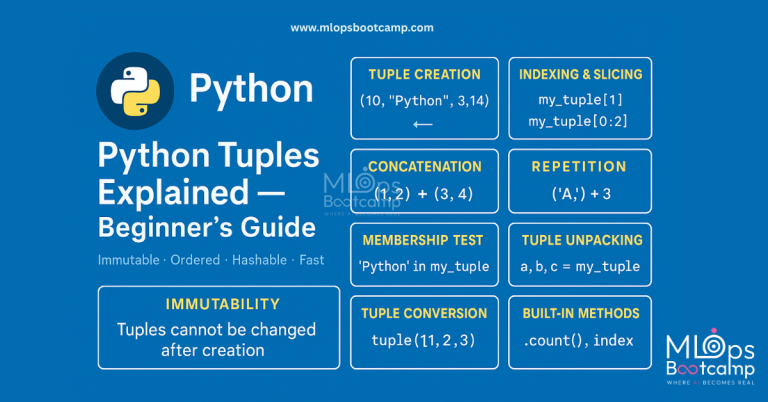
Python Lists are one of the most powerful and versatile data structures in Python. Whether you’re building a data processing script, an AI model, or a web application, you’ll find yourself working with lists frequently.
In this article, we’ll take a deep dive into Python Lists, exploring their creation, properties, and every list method with practical examples. By the end, you’ll know exactly how to use lists efficiently in real-world projects.
What Is a List in Python?
A list in Python is an ordered, mutable collection that can hold multiple data types — strings, integers, floats, or even other lists.
Example:
# Creating a simple list
my_list = [10, "Python", 3.14, True]
print(my_list)Output:
[10, 'Python', 3.14, True]In simpler terms, python lists are like containers where you can store multiple items and modify them anytime. In addition, you can mix and match data types freely.
Understanding Mutability in Python Lists
One of the key characteristics that makes Python Lists powerful is that they are mutable.
Mutability means that you can change the contents of a list after it has been created — without creating a new list in memory. You can update, add, remove, or replace elements directly.
Why Mutability Matters
- Efficient memory: Lists update in place without creating duplicates.
- Dynamic structure: They can grow or shrink anytime.
- Caution required: Since they share references, one change may affect multiple variables.
In conclusion, mutability gives lists both flexibility and power.
Immutable vs Mutable Types
| Type | Mutable | Example | Can Change? |
|---|---|---|---|
list | ✅ Yes | [1, 2, 3] | ✅ Yes |
tuple | ❌ No | (1, 2, 3) | ❌ No |
string | ❌ No | "hello" | ❌ No |
dict | ✅ Yes | {"a":1} | ✅ Yes |
How to Create a List
You can create lists using either square brackets [] or the list() constructor. Both methods are valid; however, they serve slightly different purposes.
numbers = [1, 2, 3, 4, 5]
words = list(("apple", "banana", "cherry"))The list() function is particularly helpful when converting other iterables, such as tuples or sets, into lists.
Accessing and Slicing Python Lists
You can easily access elements by index or extract sublists using slicing. Moreover, slicing helps you manipulate portions of data efficiently.
Examples of List Indexing and Slicing
fruits = ["apple", "banana", "cherry", "mango"]
# Access first element
print(fruits[0])
# Access last element
print(fruits[-1])
# Slice elements from index 1 to 3
print(fruits[1:3])Output:
apple
mango
['banana', 'cherry']Therefore, slicing is a quick way to retrieve multiple items from a list.
Python List Methods Explained
Now, let’s explore Python’s most useful list methods. Each method provides an easy way to manipulate data without complex code.
Adding and Inserting Items in Python List
1. append() – Add an element to the end
numbers = [1, 2, 3]
numbers.append(4)
print(numbers)Output: [1, 2, 3, 4]
2. extend() – Add multiple elements
numbers.extend([5, 6])
print(numbers)Output: [1, 2, 3, 4, 5, 6]
3. insert() – Insert element at a specific index
numbers.insert(2, 99)
print(numbers)Output: [1, 2, 99, 3, 4, 5, 6]
Removing Items from a Python List
4. remove() – Remove the first occurrence of an element
numbers.remove(99)
print(numbers)Output: [1, 2, 3, 4, 5, 6]
5. pop() – Remove and return an element
last = numbers.pop()
print(last)
print(numbers)Ouput
6. clear() – Remove all elements
numbers.clear()
print(numbers)Output: []
Sorting and Reversing Python Lists
7. index() – Find index of a value
fruits = ["apple", "banana", "cherry"]
print(fruits.index("banana"))Output: 1
8. count() – Count occurrences of an element
nums = [1, 2, 2, 3, 2]
print(nums.count(2))Output: 3
9. sort() – Sort the list
nums = [4, 1, 3, 2]
nums.sort()
print(nums)Output: [1, 2, 3, 4]
10. reverse() – Reverse the order
nums.reverse()
print(nums)Output: [4, 3, 2, 1]
Copying and Counting Elements in Python List
11. copy() – Create a shallow copy
new_list = nums.copy()
print(new_list)Output: [4, 3, 2, 1]
Advanced List Concepts
List Comprehension
List comprehensions make your code shorter and cleaner. They also improve performance in many cases.
squares = [x**2 for x in range(1, 6)]
print(squares)Output: [1, 4, 9, 16, 25]
Nested Lists
Lists can even contain other lists. In this way, you can create multi-dimensional data structures.
matrix = [[1, 2], [3, 4], [5, 6]]
print(matrix[1][0])Output: 3
Real-World Example: Data Filtering
temperatures = [32, 35, 30, 29, 40, 42]
hot_days = [temp for temp in temperatures if temp > 35]
print(hot_days)Output: [40, 42]
Summary Table: Python List Methods
| Method | Description | Example |
|---|---|---|
| append() | Add element to end | a.append(5) |
| extend() | Add multiple elements | a.extend([6,7]) |
| insert() | Insert at position | a.insert(1, 99) |
| remove() | Remove element | a.remove(2) |
| pop() | Remove and return | a.pop() |
| clear() | Clear list | a.clear() |
| index() | Find index | a.index(5) |
| count() | Count occurrences | a.count(2) |
| sort() | Sort list | a.sort() |
| reverse() | Reverse list | a.reverse() |
| copy() | Copy list | a.copy() |
Conclusion
Python Lists are the backbone of data manipulation and collection handling. From basic creation to complex comprehension, mastering lists gives you the flexibility to handle data dynamically.
With all these methods and best practices, you’re now ready to use Python Lists effectively in real-world projects — whether it’s a data science pipeline or an automation script.




Leave a Comment